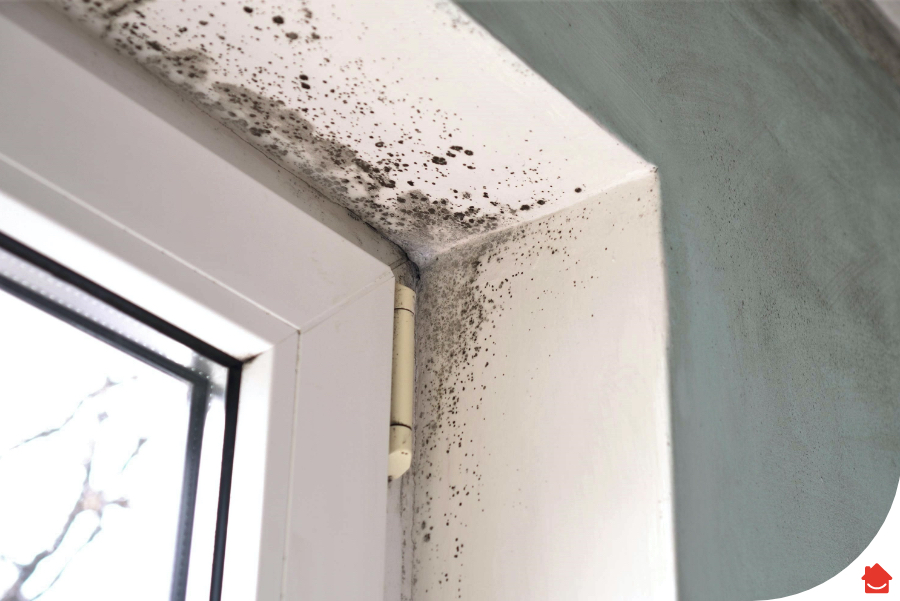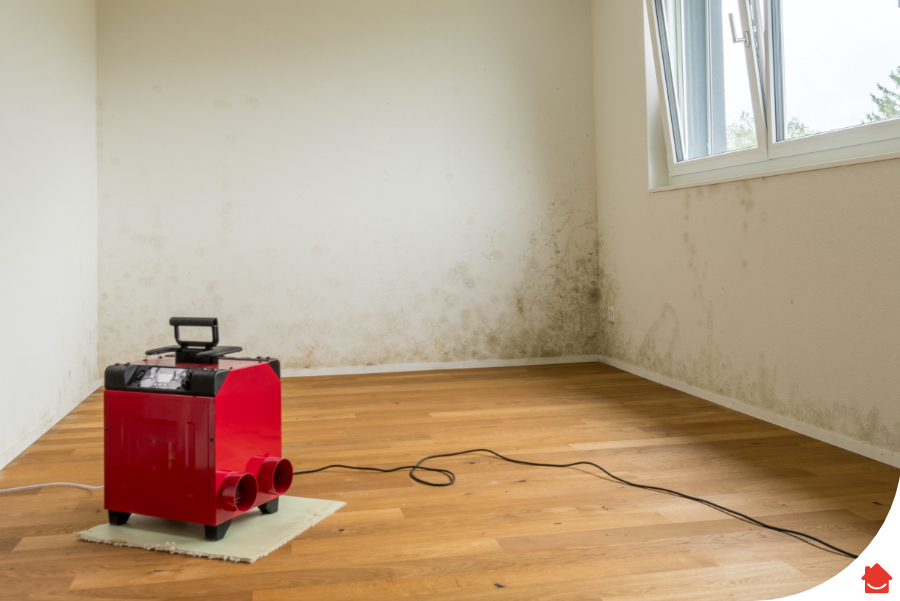Firstly, don’t panic. Just because mould is black in colour, doesn’t mean it’s harmful. There are two types of black mould, broadly speaking – toxic and non-toxic. Read on to find out the difference and follow the steps of how to get rid of it.
What is black mould?
Mould ranges in colour depending on what substance provided the food for it to grow. Black mould is a type of mould that has a black pigment. Not all black moulds are harmful, but heavy exposure to non-toxic black mould could trigger an increase in allergy and asthma symptoms.
If you want to get rid of any other type of mould, our guide to removing mould will help.
What is black toxic mould?
Black toxic mould (a.k.a. Stachybotrys chartarum) is a dark black or sometimes dark green mould. It is a highly toxic form of mould that can commonly be found in attics and lofts.
Why is black toxic mould dangerous?
The reason black toxic mould is dangerous is that the spores release mycotoxins into the air. Mycotoxins are toxic chemicals that, when inhaled, can cause a danger to human health.
What causes black toxic mould/mycotoxins?
For this kind of black toxic mould to grow, the material needs to have been wet for at least three days. Poor ventilation is deadly for developing black toxic mould because it allows moisture to hang around, sitting on surfaces and in the air.
For example, it might be in a bathroom that isn’t adequately ventilated with a fan or an open window after baths and showers.
Another example is a bathroom exhaust fan that vents upwards into the loft instead of out of a window or a vent that goes outside the house. This kind of setup produces moist, humid air that filters upwards and can trigger black toxic mould growth in your loft.
Another possible cause can be flooding or leaks that have stood stagnant for a long time. To grow rapidly, the mould requires a food source that’s high in cellulose and low in nitrogen.
Another cause can be a blocked attic vent. If you discover you have a blocked attic vent, first you need to remove any mould, and then you’ll need to repair or replace the vent immediately to remove the problem completely.
The health dangers of black toxic mould
Black toxic mould is not simply an aesthetic nuisance. Whilst non-toxic mould can trigger allergies, exposure to toxic mould could be dangerous to the body’s respiratory and neurological systems. It can be responsible for chronic health problems, such as asthma, persistent migraines, rashes, depression, tremors and even death (in some very extreme cases).
In the last 2 years to March 2019, on average 3% of households in England had dampness in at least one room of their home according to the Ministry of Housing, Communities and Local Government.
With this in mind, it’s absolutely crucial that more homeowners, landlords and tenants know how to remove black toxic mould and know how to prevent it from developing in the first place.
How to get rid of black mould
The question is, when it comes to killing black mould, whether it’s toxic or non-toxic, can we really rely on home remedies, or does it need strong stuff, like the specialist sprays on the market?
It all depends on how much black mould you’ve got in your property, and how long it’s been growing. If you’re a landlord coming back into your property after a long tenancy where the occupiers weren’t adequately ventilating the bathroom and/ or bedrooms, or a new homeowner doing a renovation of an old property, you may have a heavy case of black mould and need to do a full blitz.
The key is to find and remove the root cause of the mould before you do anything else.
Extreme cases need professionals
Severe cases of mould need to be removed by experts. This is because disturbing black toxic mould can release millions of dangerous spores into your home.
If your mould isn’t severe, however – perhaps you have only a few patches of non-toxic black mould to fix up – you can try a number of easy DIY methods to remove it but make sure you protect yourself whilst you get the job done.
- Baking soda
- Vinegar
- Bleach
- Mould removal sprays
How to treat black mould (in order of strength and severity of the problem)
For light patches:
1) Baking soda
Baking soda is an age-old cure for black mould. It works as a natural disinfectant because its pH of 8-8.1 is too high for mould to thrive.
How to apply it:
1. Stir together a mixture of 50/50 baking soda and water until it forms a paste.
2. Apply it to the patch of mould you’re treating.
3. Use a small brush or an old toothbrush to scrape away any mould-stained spots.
4. To help prevent the mould from coming back, buy a spray bottle and make a solution of one tablespoon of baking soda to a cup of water.
5. Shake the bottle.
6. Liberally spray the area you just cleaned.
7. Let it dry to form a protective layer and barrier to prevent future mould growth.
Advantages of baking soda:
- Harmless to children and pets
- No risk of damaging your home
- Effectively kills off odours
- Quickly absorbs moisture
Disadvantages of baking soda:
- Not suitable for big outbreaks of mould as it’s so mild. You’ll probably want to reach for bleach or other commercial chemical sprays.
2) White vinegar
Vinegar is another home remedy that attacks black mould from another angle. It’s acidic, with a pH of around 2.5, so works well as an antibacterial, by breaking down and killing the mould.
How to apply vinegar:
1. Spray white vinegar (neat) directly onto the affected area
2. Wait for 15 minutes
3. Spray it again
4. Use an old toothbrush to scrub away the mould
5. Wipe clean with a damp cloth
Advantages of vinegar
- Harmless to children, pets, and your environment
- No risk of damaging your property
Disadvantages of vinegar
Can leave a vinegary odour (temporarily)
Only good for mild outbreaks
3) Hydrogen Peroxide
Hydrogen peroxide is a natural 3-in-1 antiviral, antibacterial and antifungal remedy. It’s safe to use and doesn’t harm the environment. It’s especially good for removing mould from porous materials like woven fabric furniture.
1. Use 3% hydrogen peroxide
2. Mix 1 part hydrogen peroxide with 2 parts water in a spray bottle.
3. Spray liberally
4. Wait for 10 minutes
5. Now scrub the area with your old toothbrush.
6. Wipe any remaining mould away with a damp towel and let the area dry.
Advantages of hydrogen peroxide:
- Antiviral, antibacterial and antifungal
- Natural and safe
Disadvantages of hydrogen peroxide:
- Not suitable for big outbreaks
4) Tea tree oil
Tea tree oil has also been used for generations to kill mould. That’s because it’s a natural fungicide that is strong enough to prevent the return of mould.
1. Wear protective gloves – tea tree oil is a natural solution, but it can still irritate your skin if it’s neat.
2. Mix 2 teaspoons of tea tree oil with 2 cups of water in a spray bottle
3. Shake and spray liberally onto the affected area.
4. Leave it to kill the mould for 10 minutes
5. Wipe it away with a damp cloth
6. Wait for it to dry completely then spray again to help prevent future regrowth.
Advantages of tea tree oil:
- Natural fungicide
- Safe
- Prevents the return of mould
Disadvantages of tea tree oil:
- Not as strong as bleach
5) Grapefruit seed extract
Grapefruit seed extract’s main compounds are polyphenols, known as limonoids and naringenin, which help when killing bacteria in laundry, cleaning carpets and for disinfecting and sterilising spaces.
When grapefruit seed extract is used to fight black mould, the acids continue penetrating growth and prevent mould spores from returning.
1. Mix 10 drops of grapefruit seed extract oil with every 1 cup of water in a spray bottle
2. Spray liberally
3. Wait for 10 minutes to 1 hour, depending on how bad the situation is
4. Scrub with a toothbrush if you need to
5. Now wipe away any remaining residue
Advantages of grapefruit seed extract:
- Natural and safe
- Antibacterial
- Prevents spores from returning
Disadvantages of grapefruit seed extract:
- Not as strong as bleach
For more serious outbreaks on non-porous surfaces:
6) Bleach
If your mould outbreak warrants a higher strength attack, bleach is the next strongest solution – as long as your outbreak is on non-porous surfaces like ceramic tiles, metal sinks, glass or metal cabinets.
Bleach may have been the first thing you think of as a remedy when you see black mould – most homeowners do because the chlorine in bleach is highly adept at attacking the proteins of the mould spores.
However, a lot of people don’t know that bleach only works on non-porous surfaces, like the ones mentioned above, and not on things like wood or drywall. This is because bleach doesn’t penetrate any deeper than the surface unless you use it in combination with specialist detergents.
The other drawback of using bleach is its hazardous, toxic fumes, which are unsafe for children, pets and yourself to be exposed to, so should be used with extreme caution.
If it’s just non-porous surfaces that are affected by the mould:
1. Wear thick, old clothes that you don’t mind being bleached
2. Put on rubber gloves and a face mask
3. Mix one part bleach with four parts water
4. Use a small brush to gently scrub until the mould is gone
5. Wipe with a damp cloth
6. Dry the area well with a soft cloth
For extreme cases of black mould and black toxic mould:
7) Specialist mould sprays
If you have a serious mould outbreak in your property, the DIY shop stocks some pretty potent specialist treatments. One spray that’s popular with many landlords and letting agencies is HG Mould Remover Spray. It gives off some nasty fumes, so should be used with a lot of caution.
1. Make sure no children or pets are present (do it in the morning when kids are at school to leave several hours’ grace)
2. Wear appropriate protective equipment
3. Make sure the room is well ventilated
4. Spray as directed on the bottle.
Advantages of bleach and specialist mould sprays containing bleach:
- Works for severe build-ups of mould
Disadvantages of bleach and specialist mould sprays containing bleach:
- Extremely toxic and harmful to skin, children, pets and the environment
How to get rid of black mould on walls
Your trusty old toothbrush – or an old washing-up brush – can handle any of the aforementioned remedies. You’ve just got to wait long enough for your solution to have its antibacterial, antifungal or antiviral effect on the surface, then gently scrub for long enough to remove any physical signs of mould, before wiping it over with a damp cloth.
How to get rid of black mould in the shower
It’s important to get rid of all mould in the shower – including the mould that gathers in the grout. Unlike ceramic tiles, grout is extremely porous, so the mould can grow deep into it. You’ll need some elbow grease and perhaps a stronger solution to tackle this.
How to get rid of black mould in the bathroom
Your bathroom is the main stage for mould as it’s full of moist air all the time. Without adequate ventilation, this moisture has nowhere to escape, so it lingers on walls and ceilings inviting black mould in.
If you have mould in your bathroom you’ll need to be mindful of what surfaces need what kind of strength solution, eg. the ceramic tile and grouting example above, and examine how badly they are affected.
Check all around your bathroom – in airing cupboards, in corners, up high and low – and get scrubbing!
How to prevent black mould
Once you’ve removed the black mould, it’s your responsibility to make your home into a hostile environment, so it doesn’t come back. Always, always, always remember that prevention is better than cure. The secrets to avoiding the health implications and aesthetic problems of black mould in the first place are:
Excellent ventilation
This is absolutely the best defence against mould growth, especially in your bathroom. Remember, mould thrives in cold, damp areas, so increase the heat and increase the ventilation.
1. Make sure your air vent or air conditioning works properly and removes enough moisture
2. Consider buying a dehumidifier
3. Make sure air can circulate through your home in general – open windows and doors, including internal doors, as much as you can.
Nine mould prevention tips:
Here are some other precautions you can take to stop mould in its tracks:
1. Fix leaking pipes
2. Check windows are properly sealed
3. Don’t continually dry wet washing on radiators without adequate ventilation
4. Watch out for rising damp
5. Dry wet patches immediately
6. Consider mould prevention paint or additives
7. Buy a moisture meter from a DIY shop. The ideal humidity for your home is between 30% and 60%
8. If you have indoor plants, that’s great for improving the air quality of your home. However, soil and leaves provide the perfect breeding ground for mould. To stop mould from forming, make sure you move your plants around every few weeks
9. Inspect the exterior of your home regularly for leaks and blocked gutters
Extreme cases of mould
Again, if your mould problem is severe or you have health issues, we recommend you contact a mould removal expert – they’ll be able to solve the issue quickly and without risk to anyone’s health.
If you’re a landlord dealing with all the normal issues of renting a property, you might want to take preventive measures to reduce the risk of dampness and mould by having a look at our landlord’s cover. We also offer fixed-price, on-off home repairs for landlords and homeowners who want peace of mind that an expert is on hand to help when they need it the most.
FAQs
Can I remove the black mould myself?
Yes. If it is not too serious, there are a number of natural remedies you can use such as baking soda, white vinegar and tea tree oil. If the problem is severe, you may need to use bleach or contact a mould removal specialist to sort things for you.
What kills black mould?
Natural remedies like baking soda, grapefruit seed extract and white vinegar can kill mould. Stronger solutions include bleach and specialist mould removers – but be careful if you choose to opt for these.
How do I stop the black mould from coming back?
Keep your home well-ventilated. This might mean opening windows and doors more often in dry weather, investing in a dehumidifier and making sure your extractor fan works correctly. It’s also worth regularly checking that there are no exterior leaks or blocked gutters around your home, as these can cause black mould to make a return.




